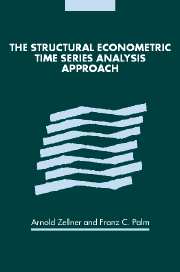Book contents
- Frontmatter
- Contents
- List of contributors
- Acknowledgments
- Introduction
- Part I The SEMTSA approach
- Part II Selected applications
- Part III Macroeconomic forecasting and modeling
- 13 Macroeconomic forecasting using pooled international data (1987)
- 14 Forecasting international growth rates using Bayesian shrinkage and other procedures (1989)
- 15 Turning points in economic time series, loss structures, and Bayesian forecasting (1990)
- 16 Forecasting turning points in international output growth rates using Bayesian exponentially weighted autoregression, time-varying parameter, and pooling techniques (1991)
- 17 Bayesian and non-Bayesian methods for combining models and forecasts with applications to forecasting international growth rates (1993)
- 18 Pooling in dynamic panel data models: an application to forecasting GDP growth rates (2000)
- 19 Forecasting turning points in countries' output growth rates: a response to Milton Friedman (1999)
- Part IV Disaggregation, forecasting, and modeling
- Subject index
- Author index
- References
13 - Macroeconomic forecasting using pooled international data (1987)
Published online by Cambridge University Press: 24 October 2009
- Frontmatter
- Contents
- List of contributors
- Acknowledgments
- Introduction
- Part I The SEMTSA approach
- Part II Selected applications
- Part III Macroeconomic forecasting and modeling
- 13 Macroeconomic forecasting using pooled international data (1987)
- 14 Forecasting international growth rates using Bayesian shrinkage and other procedures (1989)
- 15 Turning points in economic time series, loss structures, and Bayesian forecasting (1990)
- 16 Forecasting turning points in international output growth rates using Bayesian exponentially weighted autoregression, time-varying parameter, and pooling techniques (1991)
- 17 Bayesian and non-Bayesian methods for combining models and forecasts with applications to forecasting international growth rates (1993)
- 18 Pooling in dynamic panel data models: an application to forecasting GDP growth rates (2000)
- 19 Forecasting turning points in countries' output growth rates: a response to Milton Friedman (1999)
- Part IV Disaggregation, forecasting, and modeling
- Subject index
- Author index
- References
Summary
Introduction
It has long been recognized that national economies are economically interdependent (see, e.g., Burns and Mitchell 1946 for evidence of comovements of business activity in several countries and Zarnowitz 1985 for a summary of recent evidence). Recognition of such interdependence raises the question: Can such interdependence be exploited econometrically to produce improved forecasts of countries' macroeconomic variables such as rates of growth of output, and so forth? This is the problem that we address in this chapter, using annual and quarterly data for a sample of European Economic Community (EEC) countries and the United States.
We recognize that there are several alternative approaches to the problem of obtaining improved international macroeconomic forecasts. First, there is the approach of Project Link that attempts to link together elaborate structural models of national economies in an effort to produce a world structural econometric model. A recent report on this ambitious effort was given by Klein (1985). We refer to this approach as a “top-down” approach, since it uses highly elaborate country models to approach the international forecasting problem. In our work, we report results based on a “bottom-up” approach that involves examining the properties of particular macroeconomic time series variables, building simple forecasting models for them, and appraising the quality of forecasts yielded by them. We regard this as a first step in the process of constructing more elaborate models in the structural econometric modeling time series analysis (SEMTSA) approach described by Palm (1983), Zellner (1979), and Zellner and Palm (1974).
- Type
- Chapter
- Information
- The Structural Econometric Time Series Analysis Approach , pp. 457 - 484Publisher: Cambridge University PressPrint publication year: 2004
References
- 1
- Cited by

